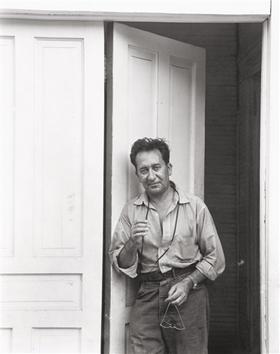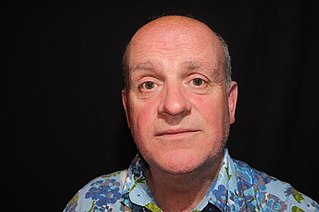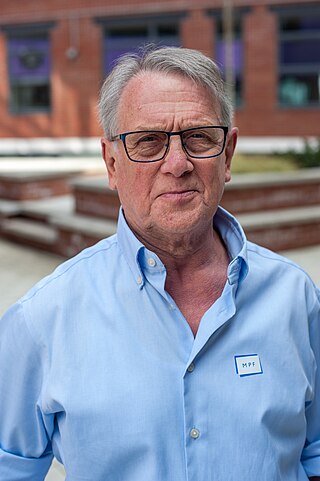Related Research Articles

Paul Strand was an American photographer and filmmaker who, along with fellow modernist photographers like Alfred Stieglitz and Edward Weston, helped establish photography as an art form in the 20th century. In 1936, he helped found the Photo League, a cooperative of photographers who banded together around a range of common social and creative causes. His diverse body of work, spanning six decades, covers numerous genres and subjects throughout the Americas, Europe, and Africa.

Horst P. Horst was a German-American fashion photographer.
Lewis Frederick Morley was a photographer.

Aaron Siskind was an American photographer whose work focuses on the details of things, presented as flat surfaces to create a new image independent of the original subject. He was closely involved with, if not a part of, the abstract expressionist movement, and was close friends with painters Franz Kline, Mark Rothko, and Willem de Kooning.
Robert Carlos Clarke was a British-Irish photographer who made erotic images of women as well as documentary, portrait, and commercial photography.
Christopher David Killip was a Manx photographer who worked at Harvard University from 1991 to 2017, as a Professor of Visual and Environmental Studies. Killip is known for his black and white images of people and places especially of Tyneside during the 1980s.

Harriet Candace "Rose" Clark (1852–1942) was an early 20th-century American painter and pictorial photographer. She is best known for the photographs she exhibited with Elizabeth Flint Wade under their joint names, either as "Rose Clark and Elizabeth Flint Wade" or as "Misses Clark and Wade".

Timothy Walker HonFRPS is a British fashion photographer who regularly works for Vogue, W and Love magazines. He is based in London.
Jimmy DeSana was an American artist, and a key figure in the East Village punk art and New Wave scene of the 1970s and 1980s. DeSana's photography has been described as "anti-art" in its approach to capturing images of the human body, in a manner ranging from "savagely explicit to purely symbolic". DeSana was close collaborators with photographer Laurie Simmons and writer William S. Burroughs, who wrote the introduction to DeSana's self-published collection of photographs Submission. His work includes the album cover for the Talking Heads album More Songs about Buildings and Food as well as John Giorno’s LP, You’re The Guy I Want To Share My Money With.
The Deutsche Börse Photography Foundation Prize is awarded annually by the Deutsche Börse Photography Foundation and the Photographers' Gallery to a photographer who has made the most significant contribution to the photographic medium in Europe during the past year.

Mark Keith Laurie is a Canadian photographer, specializing in female fine art photography and digital photography. He is also a teacher, speaker, author, and studio mentor.

Paul Reas is a British social documentary photographer and university lecturer. He is best known for photographing consumerism in Britain in the 1980s and 1990s.
Colin Jones was an English ballet dancer-turned-photographer and prolific photojournalist of post-war Britain.
Bruce Bernard was an English picture editor, writer and photographer. He wrote for the Sunday Times and the Independent and photographed many influential artists in a career lasting nearly 40 years. Some of Bernard's prints are held in the collection of the National Portrait Gallery, London.

John Myers is a British landscape and portrait photographer and painter. Between 1973 and 1981 he photographed mundane aspects of middle class life in the centre of England—black and white portraits of ordinary people and suburbia within walking distance of his home in Stourbridge.
Susan Lipper is an American photographer, based in New York City. Her books include Grapevine (1994), for which she is best known, Trip (2000) and Domesticated Land (2018). Lipper has said that all of her work is "subjective documentary"; the critic Gerry Badger has said many describe it as "ominous".

Susan Elizabeth Davies OBE HonFRPS was the founder of The Photographers' Gallery in 1971, Britain's first independent gallery of photography, which she directed until 1991.
Brian James Griffin was a British photographer. His portraits of 1980s pop musicians led to him being named the "photographer of the decade" by The Guardian in 1989. His work is held in the permanent collections of the Arts Council, British Council, Victoria and Albert Museum and National Portrait Gallery, London.
Craig Easton is a British photographer who lives in The Wirral and works on long-term social documentary projects that deal with the representation of communities in the North of England. He has made work about women working in the UK fish processing industry; about the inter-generational nature of poverty and economic hardship in Northern England; about social deprivation, housing, unemployment and immigration in Blackburn; and about how the situation in which young people throughout the UK live, influences their aspirations.
Kenneth James Griffiths was a New Zealand-born photographer, best remembered for his advertising and photojournalism from the 1970s onwards.
References
- 1 2 "Laurie Lewis (1944-), Photographer". National Portrait Gallery. Archived from the original on 15 June 2024. Retrieved 15 June 2024.
- 1 2 Ashon, Will (6 June 2017). "Please keep the flames to six feet! The wild and wonderful world of Walthamstow art school". The Guardian. Retrieved 15 June 2024.
- ↑ Lewis, Laurie (28 November 2023). "Michael Spry obituary". The Guardian. Retrieved 15 June 2024.
- ↑ "Bloodthirsty triumph over evil". The Independent. 29 June 1988. p. 13. Retrieved 15 June 2024.
- ↑ "A bat slow to take flight". The Independent. 11 January 1989. p. 17. Retrieved 15 June 2024.
- ↑ Norton, Yates (3 February 2011). "A portrait of the artist as a photographer". Varsity. Retrieved 15 June 2024.
- ↑ "Gandolfi - Family Business - Production Team". Gandolfi Film website. Archived from the original on 23 May 2004. Retrieved 15 June 2024.
- ↑ Davison, Phil (2 September 2014). "Ken Griffiths obituary". The Guardian. Retrieved 15 June 2024.